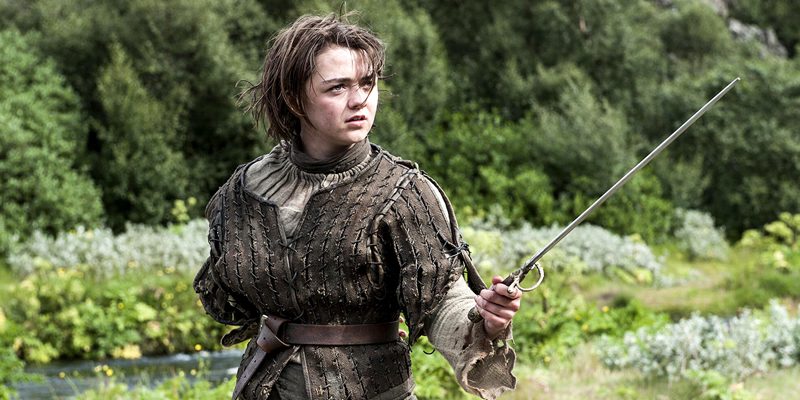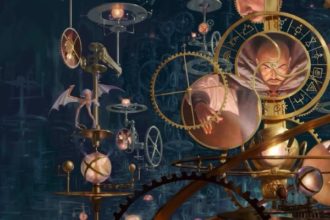Playing Younger Characters – D&D 5e

This week on the Campaign Trail I’m looking at player characters (PCs) that are younger than what is assumed by the player’s handbook. There are many reasons players ask to play a child character, such as my kids who want to play PCs that match their age in real life. There are great examples of younger characters out there that might inspire a player such as Alice In Wonderland, Peter Pan, Harry Potter, Arya Stark, Arthur “Wart” Pendragon or Laurana Kanan (a young 75 year old elf). This article provides you and your players with some ideas for taking on this character building and roleplaying challenge.
Younger characters are basically just a character who has falls into an age range below that assumed by the rules. As in life, children can be mentally and physically talented, but they have not yet reached their potential. When playing a younger character you can play the regular rules and just make a character who fits your idea of someone a little younger. You could add mechanics to the game to restrict the abilities, advancement and options of younger players, but that isn’t fun or how things are done in 5th edition. So I’d like to propose the following for playing younger characters.
Adjusting Encounters & Traps
Throwing deadly encounters and traps at younger players who are playing a younger PC might not be a great idea. You might still put their character in peril, but you might remove the threat of death. You could also create adventures that are more about helping NPCs with problems, exploring and solving puzzles. You might even want to go the route of capturing monsters versus killing them. Playing really young characters in D&D should be avoided and I would recommend another game such as No Thank You, Evil, FATE or Hero Kids.
Age, Height & Weight Adjustments
In chapter 4 of the player’s handbook there is a table for figuring out your character’s height and weight. The following table provides ideas for adjusting your height for younger PCs. You could also just have the PCs be the same approximate height and weight as the players who are playing them.
Roll the adult height and weight and then make a temporary adjustments using the table below until your character reaches adulthood. I consulted some human youth average height and weight charts for some ideas on how to create these numbers. Sadly, I was unable to find charts for the other races since they do not exist in real life.
- For characters on the low side of the age rage roll 1 die and roll 2 die for characters on the higher side of the range.
- The youngest gnomish, dwarven and elven adventurers would be fully grown physically around the same time as humans, but treated like children by their societies for a longer period.
- As characters get closer to adulthood you might bump up their height and weight as they level and/or time passes in game. This can even be another “reward” to hand out when they level or complete adventures.
| Race | Youth Range | Modifier | Height | Weight |
|---|---|---|---|---|
| Dragonborn | 4 to 13 | 1d8 | 2d8 | 5’2″ + Mod | 155 lb. + (Mod x 2d6 lb.) |
| Dwarf | 18 to 45 | – | No change | No change |
| Elf | 18 to 95 | – | No change | No change |
| Gnome | 20 to 39 | 1d4 | 2d4 | 2’8″ + Mod | 28 lb. + (Mod x 1 lb.) |
| Halfling | 12 to 19 | 1d4 | 2d4 | 2’2″ + Mod | 28 lb. + (Mod x 1 lb.) |
| Half-elf | 10 to 17 | 1d8 | 2d8 | 4’4″ + Mod | 80 lb. + (Mod x 2d4 lb.) |
| Half-orc | 6 to 12 | 1d10 | 2d10 | 4’4″ + Mod | 115 lb. + (Mod x 2d6 lb.) |
| Human | 8 to 14 | 1d10 | 2d10 | 4’2″ + Mod | 80 lb. + (Mod x 2d4 lb.) |
| Tiefling | 8 to 14 | 1d8 | 2d8 | 4’4″ + Mod | 80 lb. + (Mod x 2d4 lb.) |
Example: Dragonborn, 10 yrs. old
Modifier: 2d8 – rolled: 9 (4+5)
Youth Height: 5’2″ + 9″ = 5’11”
Youth Weight: 155 lb. + (9 x (3+5) lb.) = 227 lb.
Adult Height: 5’6″ + 9″ = 6’3″
Adult Weight: 175 lb. + (9 x (3+5) lb.) = 247 lb.
Example: Halfling, 13 yrs. old
Modifiers: 1d4 – rolled: 5 | 2d4 – rolled: 10 (5+5)
Youth Height: 2’2″ + 5″ = 2’7″
Youth Weight: 28 lb. + (1 x 5 lb.) = 33 lb.
Adult Height: 2’7″ + 10″ = 3’5″
Adult Weight: 35 lb. + (1 x (5+5) lb.) = 45 lb.
Example: Human, 13 yrs. old
Modifier: 2d10 – rolled: 13 (7+6)
Youth Height: 4’2″ + 13″ = 5’3″
Youth Weight: 80 lb. + (13 x (2+3) lb.) = 145 lb.
Adult Height: 4’8″ + 13″ = 5’9″
Adult Weight: 110 lb. + (13 x (2+3) lb.) = 175 lb.
Stat Adjustments & Other Considerations
- If everyone is playing younger players you could just use the normal statistics and just have the characters be younger when it comes to roleplaying.
- If a player wants to create a younger PC they could just set strength, constitution and wisdom as their lowest scores and build them up over time. A fighter could move from using dexterity based attacks to heavy strength based weapons as they age and level in game.
- You could use a lower array such as 14, 12, 12, 11, 10, 8 and give and extra +2 when they reach level 4 and are older.
- You could adjust monsters and adult NPCs to have higher stats in Strength, Constitution or Wisdom to balance out the youthful PCs stats.
- You could have younger players be squires/apprentices or start at level 0 or level 1, reaching adulthood by level 3. I’d love to run an adventure where the big strong veteran heroes get captured and their novice trainees have to save the day.
Pathfinder’s Ultimate Campaign limits class options (Aristocrat, Commoner, Expert, Adept and Warrior), slows trait progression and set younger characters with a +2 bonus to Dexterity and a –2 penalty to Strength, Constitution, and Wisdom.
Stats for Younger Players Table
Younger characters are generally lighter and weaker, so I adjusted strength down and dexterity up. The following table provides guidelines on adjusting the statistics for younger PCs. When they move out of the youth range you can use the default stats for their race.
- The youngest gnomish, dwarven and elven adventurers would be fully grown physically, so they do not require an adjustment, but I’m sure they could use a penalty to wisdom like all the races on this list could use.
- These adjustments make Halflings superpowered, so I made them take an additional hit to Wisdom – but you might want to just keep them hidden away in their shires until they reach 20, which is still very young to go out adventuring for a
HobbitHalfling. As an alternative, just have young halflings set their Strength and Wisdom as their lowest scores.
| Race | Youth Range | Adjusted Stats |
|---|---|---|
| Dragonborn | 3 to 13 | STR+1, DEX+1, CHA+1 |
| Dwarf | 18 to 45 | No Adjustments |
| Elf | 18 to 95 | No Adjustments |
| Gnome | 18 to 39 | No Adjustments |
| Halfling, Lightfoot | 12 to 19 | STR-1, DEX+3, CHA+1, WIS -1 (or just make STR and WIS their lowest scores) |
| Halfling, Stout | 12 to 19 | STR-1, DEX+3, CON+1, WIS -1 (or just make STR and WIS their lowest scores) |
| Half-elf | 11 to 17 | STR-1, DEX+1, INT+1, CHA+2 |
| Half-orc | 6 to 12 | STR+1, DEX+1, CON+1 |
| Human | 8 to 14 | STR-1, DEX+1, INT+1, CHA+1 and +1 skill, +1 feat |
| Tiefling | 8 to 14 | STR-1, DEX+1, INT+1, CHA+2 |
Let me know what you think in the comments below. Try out some numbers and let me know how close or far they seem. I’m sure this will need lots of tweaking.
If you liked this article and other articles on Tribality.com, please consider supporting us on Patreon.



